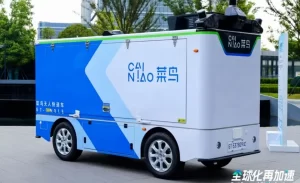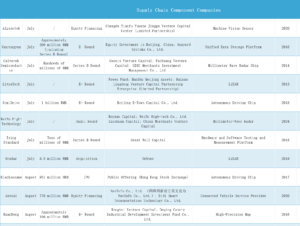The advancement of technology will drive AGVs to penetrate further into various stages of baijiu manufacturing.

The main process flow of Baijiu production – CMRA
Baijiu Production Process and the Application of AGV
Generally speaking, the main process flow for Baijiu production includes the following steps: making qu, steaming grains, fermentation, distillation, aging, blending, and bottling. While brands and types of liquor may vary, the overall brewing process remains largely consistent. Therefore, using Baijiu production as an example, the application of AGV/AMR can be primarily seen in the following stages:
Raw Material Storage and Transportation: AGV can be used for the storage and transportation of Baijiu raw materials. For instance, AGV can transport materials like distiller grains and grains within the raw material warehouse without the need for manual handling, thus saving a significant amount of labor.
Making Qu: Making koji is the initial step in Baijiu production, and much of this process still relies on manual labor. Some companies have started using AGV for the automated handling and storage of koji blocks during the koji-making process. In the process of turning over the koji, there are also applications of flip-forklift AGVs for the first and second flips. Using flip-forklift AGVs for koji flipping effectively addresses challenges related to temperature and humidity control and safety concerns in manual operations, ultimately enhancing production efficiency.

Production Process of Baijiu Fermentation Starter and Illustrated Application of AGV – CMRA
Fermentation and Distillation: In the fermentation and distillation stages of Baijiu production, AGVs can be employed to transport raw materials from fermentation tanks to distillation equipment. Furthermore, AGVs can collaborate with robots or other automated systems to perform more complex tasks, such as transferring distilled Baijiu from distillation apparatus to storage containers.
Aging and Blending: In the aging and blending phases of Baijiu production, AGVs can be utilized to blend and mix Baijiu of different vintages and qualities. Additionally, AGVs can transport aged Baijiu from aging rooms to designated storage areas.
Bottling: In the traditional bottling process of liquor production, primary packaging includes jars, ceramic bottles, glass containers, as well as packaging materials like cardboard. This process is often carried out manually or with basic machinery, resulting in low efficiency and an inability to meet bulk production demands. At present, there are mature automated production lines for bottling, sealing, and packaging finished liquor products. With the introduction of mobile robots, robotic arms, computer monitoring systems, and more, packaging quality is strictly controlled, product quality can be traced back to its source, and packaging efficiency is significantly improved, thus avoiding packaging quality issues caused by manual operations.
Finished Product Storage and Transportation: Finally, AGVs can also be used for the storage and transportation of finished products. For instance, AGVs can transport finished liquor from the warehouse to designated storage areas or move entire pallets of liquor bottles from the warehouse to loading zones for shipment.

Automation and AGV Application in Some Chinese Liquor Companies – CMRA
Faced with the urgent market demands in the liquor industry, several mobile robot manufacturers have developed a range of intelligent equipment and systems tailored for the beverage sector. Among them, Kunshan Intelligent’s roller-type AGV, warehousing logistics AGV, and other products have been applied in liquor companies such as Shuanggou Liquor, Jiannanchun, Shanxi Fenjiu, Shede Winery, and Luzhou Laojiao. Additionally, a series of AGVs from companies like Siasun and Jiashun Intelligent are also being used in the brewing industry.

KSEC Intelligent AGV in the Fermentation Warehouse of a Chinese Liquor Factory – CMRA
Challenges in the Application of AGVs in the Brewing Industry
Currently, the use of AGV systems in the brewing industry is still in its early stages due to various factors such as technological limitations and environmental constraints. It is primarily limited to applications in finished product transportation and warehouse management. Liquor industry end-users urgently need to enhance their level of automation in production, and mobile robot manufacturers are eager to break through the limitations of AGV applications in this industry.
Here are some of the challenges in AGV application in the brewing industry:
Complex Production Environment: The production process of liquor involves multiple stages, including raw material storage, fermentation, distillation, and storage, each with specific temperature, humidity, and atmosphere requirements. This places high demands on the materials and technology used in AGVs.
Precision Operations: Liquor production involves a series of precise operations such as ingredient mixing, liquid transfer, and bottling. AGVs need to accurately identify and operate relevant equipment and tools.
High Level of Automation: Brewing production lines typically require a high level of automation, including automated ingredient blending, liquid transfer, and bottling. This presents challenges in terms of the automation level and intelligence capability of AGVs.
High Safety Requirements: Liquor production involves flammable substances such as alcohol, so safety is a critical consideration. AGVs must have safety features such as explosion-proof design and automatic obstacle avoidance to ensure the safety of the production process.
Customized Liquor Production: As consumer preferences for liquor become more personalized, the production of customized and personalized liquors is increasing. This places higher demands on the flexibility of intelligent logistics systems. Utilizing consumer data and logistics systems for advanced scheduling is essential to address the timeliness of personalized production.
Data Interchange and System Integration: AGV applications require data exchange and integration with other equipment and systems, such as warehouse management systems and production planning systems. This requires technical support and system integration capabilities.
In summary, the challenges in the application of AGVs in the brewing industry include the complex production environment, precision operation requirements, a high level of automation, high safety requirements, and data interchange and system integration. Overcoming these challenges is essential to achieving effective AGV application in liquor production.
Overall, while AGVs may not yet be deeply integrated into the brewing process itself, they can provide automated and intelligent solutions for material handling, finished product transportation, and warehouse management, thereby improving production efficiency and management. It is believed that advancements in technology will facilitate the broader application of AGVs in more aspects of liquor manufacturing in the future.










